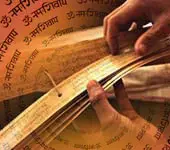Agni Vidya: The Concept of Energy in the Vedas

Energy is a fundamental concept in both Vedic philosophy and modern science. The Vedas contain numerous references to Agni (fire), which represents energy in various forms. This article explores the concept of Agni Vidya as described in the Vedas, its connection to modern physics, and the principles governing energy transformation.
Agni and Energy in the Vedas
The four Vedas contain hundreds of mantras related to Agni, describing its qualities, nature, functions, and vast presence. In modern science, energy is studied in various forms such as force, motion, heat, sound, light, magnetism, electricity, and nuclear energy. Many of these aspects are inherently linked to Agni Vidya in the Vedic texts.
The Eternal Nature of Energy
A fundamental law of modern physics states: 'Energy can neither be created nor destroyed; it can only be transformed from one form to another.' This concept aligns with Vedic teachings, where Agni is considered the eternal representative of energy. The study of Agni in the Vedas is essentially the study of energy transformation and conservation.
The Yajurveda affirms the indestructibility of energy:
- 'Agni is placed as immortal among mortals.' (Yajurveda 12.24)
- 'Agni became immortal by its potential (energy).' (Yajurveda 12.25)
Transformation of Energy
The Vedas state that Agni (energy) is singular in essence but takes on multiple forms through transformation. This leads to different manifestations of energy, each with its unique characteristics and functions.
- Since energy has the ability to create and sustain, it is called Vishwakarma (universal creator).
- Due to its ability to assume different forms, it is referred to as Pururupa (many-formed).
- Since energy exists in multiple manifestations such as sound, light, heat, and motion, it is termed Vishwarupa (universal form).
- Energy often moves in clusters, and hence it is described as Sanhat (aggregated form).
Supporting Vedic References:
- 'Among the gods, it is one, though known by many names.' (Rigveda 10.82.3)
- 'O Agni, you have a hundred forms.' (Rigveda 2.2.9)
- 'It is vast and possesses universal forms.' (Rigveda 3.1.7)
Energy as a Concentrated Force
In the Vedic texts, energy is often measured in terms of its intensity, described using numerical values such as hundreds and thousands of horsepower. Agni is referred to as:
- Shatin (100 horsepower)
- Sahasrin (1000 horsepower)
- Urjapati (lord of energy)
- Sahasah Sunuh (son of power)
Supporting Vedic References:
- 'O Agni, you have a hundred forms.' (Rigveda 2.2.9)
- 'O Agni, grant vast and thousandfold energy.' (Rigveda 2.2.7)
- 'O son of power, lord of energy.' (Rigveda 8.19.7)
Gavishti and Ashwamishti: Technical Terms for Energy Studies
The Vedas contain technical terms related to energy analysis. Two important concepts are:
- Gavishti: Derived from 'Go' (sun rays) and 'Ishti' (sacrifice), this term refers to the study and analysis of solar energy.
- Ashwamishti: Derived from 'Ashwa' (horse) and 'Ishti' (sacrifice), this term signifies the measurement of energy in terms of horsepower. Modern science defines one horsepower (H.P.) as 745.7 watts per second, a concept similar to the Vedic Ashwamishti.
Supporting Vedic References:
- 'O Indra, for Gavishti and Ashwamishti.' (Rigveda 8.61.7)
- 'O Agni, for Ashwamishti.' (Rigveda 2.6.2)
The Vedic understanding of energy, as represented by Agni, aligns closely with modern scientific principles. The concepts of energy transformation, conservation, and measurement were deeply explored in the Vedas. Agni Vidya provides a profound insight into the eternal and indestructible nature of energy, reinforcing its significance in both spiritual and scientific realms.

English
Vedas
Click on any topic to open
- 98 Agni Vidya: The Concept of Energy in the Vedas
- 97 Meaning of Durga Suktam
- 96 Calming the Fierce Within: How Food Transforms Rudra into Shiva
- 95 Puja Offerings: Physical and Mental
- 94 Understanding Deva-Tattva
- 93 How many Vedic Gods are there - 33 crores or 33?
- 92 Do Gods Possess Bodies Like Us?
- 91 Understanding the Asuras: A Deeper Insight
- 90 Vedic vs. Worldly People: Spiritual Goals vs. Material Enjoyment
- 89 Infusing Life Force into Grains: A Vital Vedic Practice
- 88 Vedic Insights on the Spiritual Potential of Humans
- 87 The Divine Within: Understanding the Human Body as a Dwelling Place of Devas
- 86 Wealth in the Vedic Society
- 85 Culture vis-a-vis Agriculture
- 84 Whenever I have Read any Part of the Vedas
- 83 Vedas - Holy Books Of Hinduism
- 82 How The Vedas Manifested Into Material Objects
- 81 What does Rigveda contain?
- 80 Why Vedas are called Shruti?
- 79 What Vedas say about periods
- 78 How Vedas Came Into Existence
- 77 Vedas are eternal, not written by anyone
- 76 Relationship Between The Vedas And The World
- 75 Why You Should Not Speak While Performing Yajna
- 74 You Should Contemplate Upon Every Step In The Yajna
- 73 Can You Take Food On The Previous Night of Yajna?
- 72 Governance In The Vedas
- 71 Aghamarshana Suktam
- 70 Significance Of Water In The Yaga-Vedi
- 69 Concept Of Taxation and Regulation Developed From The Vedas
- 68 Meaning Of Satyanarayana
- 67 Veda mantras may have different meanings
- 66 When Devas give to us we should also give back
- 65 Vedic prayers are simple and straight forward
- 64 The significance of vrata observed on the previous day of yaga
- 63 Performing yaga is progressing from worldly life to divine state
- 62 Praying to Agni to manifest himself in his evil-torturing aspect
- 61 Evil forces self declare and surrender before Agni
- 60 Why ahuti of ghee in Agni should be in measured quantity
- 59 Do demons exist?
- 58 Why special procedure is followed in yajnas
- 57 This according to Veda is the best spiritual path
- 56 Every mantra has got two Rishis
- 55 Why do Rishis say that water can heal
- 54 There are quacks in the field of Vedas and Mantras also
- 53 How much pleasure can you enjoy?
- 52 Veda cautions about indiscriminate propagation of Vedantic principles
- 51 Do you know why we consider Kaala and Varuna as Gods?
- 50 Concept of time in the Vedas- Part 2
- 49 Concept of time in the Vedas- Part 1
- 48 Do you know why you get distracted during sadhana?
- 47 Water is the mother of Gold
- 46 There is a Mother-Child relationship between water and all living beings
- 45 Vedic insights about cows and milk
- 44 Do you know why many people are away from God?
- 43 Agajanana padmarkam- famous Ganesha shloka explained
- 42 Some very interesting Vedic insights about water
- 41 Is your body something inferior and to be despised?
- 40 Ganesha Atharva Sheersha explained - Part 4
- 39 Ganesha Atharva Sheersha explained - Part 3
- 38 Ganesha Atharva Sheersha explained - Part 2
- 37 Ganesha Atharva Sheersha explained - Part 1
- 36 Sri Rudram Explained - Conclusion
- 35 Sri Rudram Explained - Anuvaka 11
- 34 Sri Rudram Explained - Anuvaka 10
- 33 Sri Rudram Explained - Anuvaka 9
- 32 Sri Rudram Explained - Anuvaka 8
- 31 Sri Rudram Explained - Anuvaka 7
- 30 Sri Rudram Explained - Anuvaka 6
- 29 Sri Rudram Explained - Anuvaka 5
- 28 Sri Rudram Explained - Anuvaka 4
- 27 Sri Rudram Explained - Anuvaka 3
- 26 Sri Rudram Explained - Anuvaka 2
- 25 Sri Rudram Explained - Anuvaka 1
- 24 Sri Rudram Explained - Introduction
- 23 Do you know the meaning of the mantra - Shuklambaradharam
- 22 There is nothing wrong in praying for wealth
- 21 Shiva Tandava Stotram Meaning
- 20 Do you know why water is so divine and why water can purify?
- 19 A mantra from Atharva Veda used in warfare
- 18 Shareeram me vicharshanam- prayer by a student
- 17 Pricchami Tva- four kinds of death explained
- 16 Mahaganapathy Moola Mantra explained
- 15 Importance of Annadaana explained in Veda-Part 3
- 14 Importance of Annadaana explained in Veda-Part 2
- 13 Importance of Annadaana explained in Veda-Part 1
- 12 Agnih Purvebhihi- Rigveda Mantra Explained
- 11 Ye Trishaptaha- explained- Part 4
- 10 Ye Trishaptaha- explained- Part 3
- 9 Ye Trishaptaha- explained- Part 2
- 8 Ye Trishaptaha- explained- Part 1
- 7 Ishe Tvorje Tva Explained - Part 3
- 6 Ishe Tvorje Tva Explained - Part 2
- 5 Ishe Tvorje Tva Explained - Part 1
- 4 Agnimeele Purohitam explained- Part 2
- 3 Agnimeele Purohitam Explained - Part 1
- 2 Somapushana Mantra: Cure for Skin Issues
- 1 Understanding a Vedic Mantra for Intellect and Retention
7
30
Astrology
Atharva Sheersha
Bhagavad Gita
Bhagavatam
Bharat Matha
Devi
Devi Mahatmyam
Ganapathy
Glory of Venkatesha
Hanuman
Kathopanishad
Mahabharatam
Mantra Shastra
Mystique
Practical Wisdom
Purana Stories
Radhe Radhe
Ramayana
Rare Topics
Rituals
Rudram Explained
Sages and Saints
Shiva
Spiritual books
Sri Suktam
Story of Sri Yantra
Temples
Vedas
Vishnu Sahasranama
Yoga Vasishta